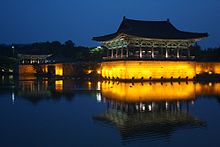Wolji
| Korean spelling | |
|---|---|
| Korean alphabet : | 안압지 |
| Hanja : | 雁 |
| Revised Romanization : | Anapji |
| McCune-Reischauer : | Anapchi |
The Wolji ( German "pond reflecting the moon" ), formerly Anapji , ( German "duck and goose pond" ), also Imhaejeonji ( German "pond with buildings overlooking the water" ) is a pond in Gyeongju , South Korea , which used to be part of a palace complex was.
The artificial pond is located in the southeast of the city on the main street Wolseongno . It was originally built in 674 by Munmu , the 30th King of Silla . The bank of the pond, which is oval in plan, was enclosed by a wall. The pond measures 200 meters from east to west and 180 meters from north to south. There are three small islands in the pond. If you take the small peninsula in the lake as a symbol for the Korean peninsula , the three islands could represent Kyushu , Jejudo and Taiwan .
In 935 a fire destroyed the five pavilions and the remains fell into the pond. In 1975 the lake was drained for restoration and the remains of the buildings were discovered, and the reconstruction of three pavilions on the west bank began. 730 of the 33,000 finds from the pond are on display in the Gyeongju National Museum, including roof tiles, other rubble from the buildings, jugs, bronze figures of Buddha, jewelry and everyday objects.
literature
- Seung-Hae Choi, Ju-Han You: Analysis of Actual Flora and Landscape Planting Species of Donggung Palace and Wolji Pond in Gyeongju , Journal of the Korean Institute of Landscape Architecture, Volume 43, Issue 3 (2015), pp. 1-12 , Korean Institute of Landscape Architecture, doi : 10.9715 / KILA.2015.43.3.001 (Korean).
Web links
Individual evidence
- ↑ Doosan Encyclopedia: 안압지
- ↑ a b c Lonely Planet: Korea , 7th edition, 2007.
- ↑ Asian Historical Architecture: Anapji Royal Pond, Gyeongju, Korea, South
- ↑ Jeon Deog-jae: Materials and Trends in the Study of Ancient Korean Wooden Slips , The Review of Korean Studies (2012).
- ↑ 안압지 ( Memento from March 21, 2014 in the web archive archive.today )
Coordinates: 35 ° 50 ′ 5 ″ N , 129 ° 13 ′ 37 ″ E





